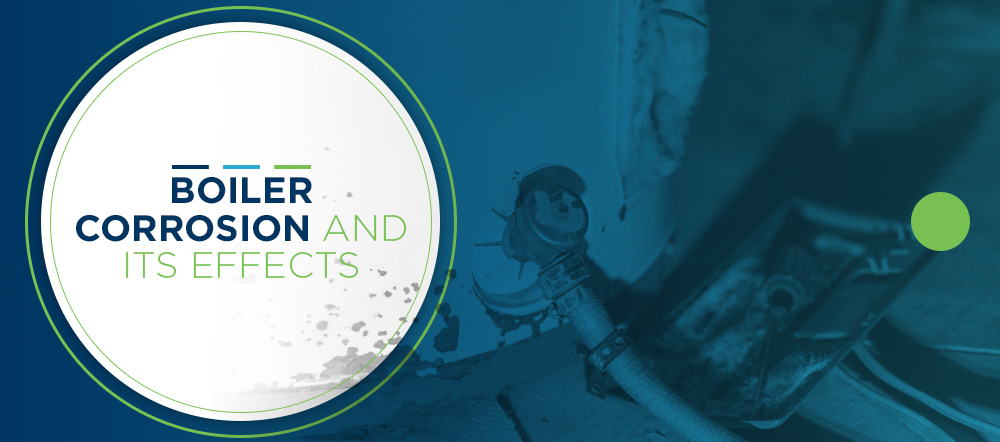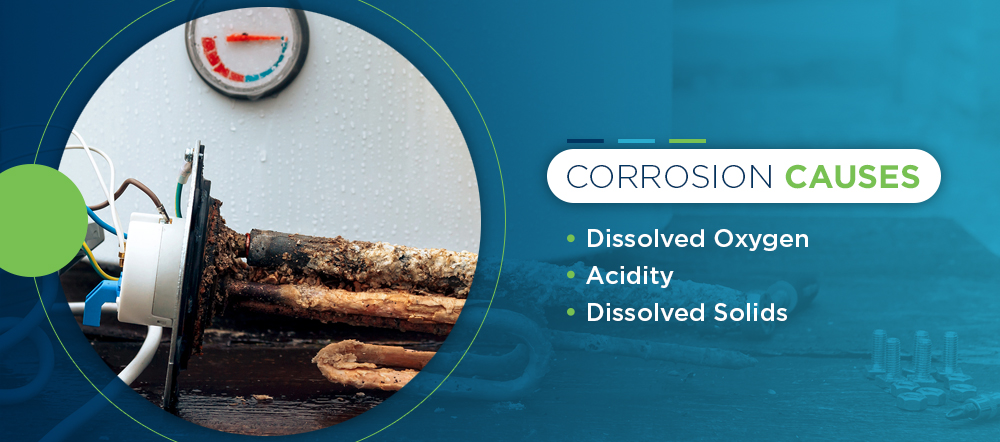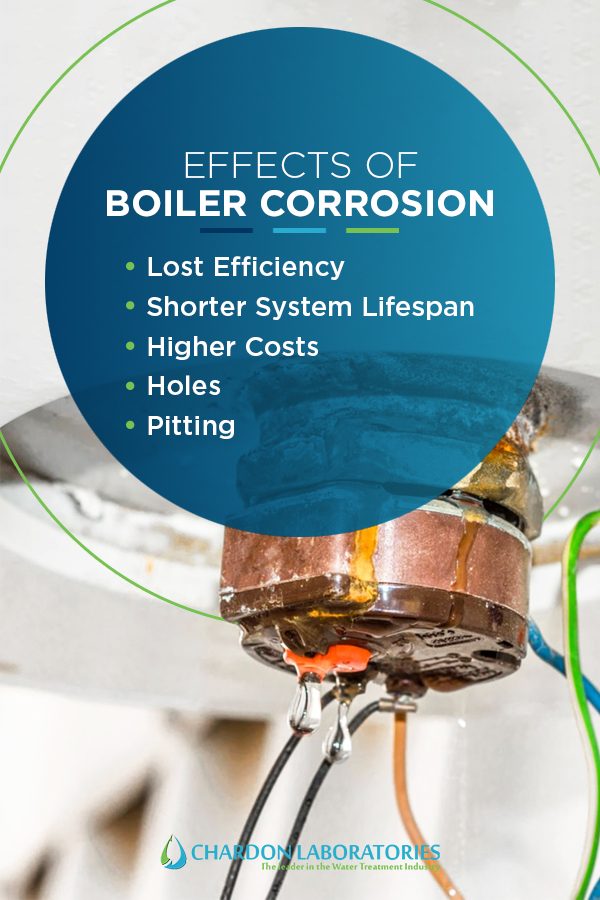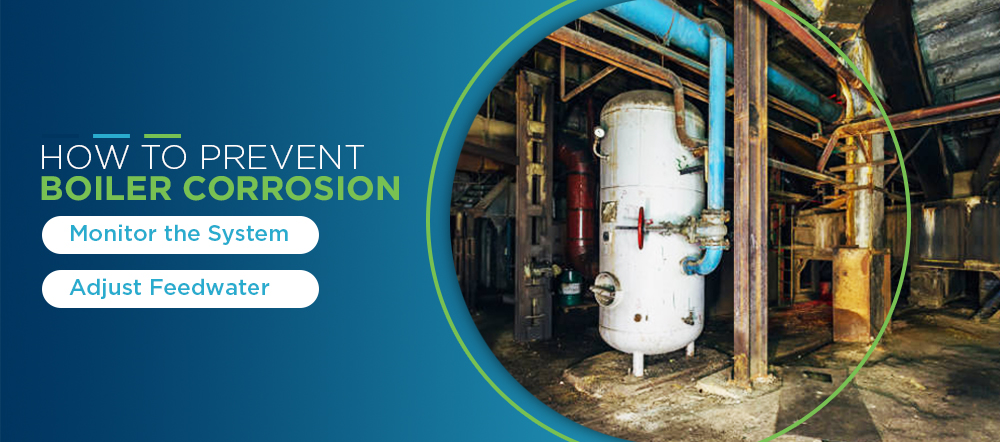
Boiler corrosion causes serious ramifications, as the cause of half of outages and almost all tube failures of boilers in power plants. Power generation plants are not the only ones affected by corrosion and failure of boilers. Any facility that uses steam boilers can experience disruptions from corrosion damage.
Repairing the effects of corrosion is both costly and challenging. To save on these repair and replacement costs, you must do everything possible to prevent erosion. Though it can feel like an uphill battle keeping your boiler free of corrosion, doing so will save your facility money and downtime.
Corrosion has several causes, but many relate to the chemistry of the water. Acidity and dissolved oxygen and solids can contribute to corrosion in a boiler. Maintaining a balance of these substances can prevent damage to the system if you understand why out of range levels for these can create pitting of metal.

In the presence of oxygen, steel breaks down into either insoluble or soluble iron compounds. Oxygen will cause pitting in the preboiler section and in the tubes. Scavenging the oxygen through the use of catalyzed sodium sulfite or hydrazine chemically removes oxygen. This process helps either instead of mechanical deaeration or after the process.
Acidity also impacts the corrosion of boiler material. Acid corrosion often occurs in the condensate return portion of the system. Low pH levels, indicating more acidic water, is among the top three causes of corrosion, along with dissolved oxygen and weakened areas of metal. Though water seems benign, dissolved gases in it can affect its pH level, which leads to wear of the surfaces inside your boiler. For example, carbon dioxide can make water acidic, which contributes to the pitting of the metal.
Acid attacks can happen from other chemicals than carbon dioxide. In high-pressure boilers, soluble nickel or magnesium salts can hydrolyze into acids. These acids attack the surfaces inside the boiler, leading to further pitting and corrosion.
Solids in the water may also contribute to corrosion formation. For example, calcium and magnesium salts, silica, manganese and iron can all form scale in a boiler. When they deposit onto the metal, these scale-forming minerals can trap sodium salts under them. While sodium salts do not cause buildup, they can cause pitting and corrosion under the scale, which will remain unseen until you remove the scale.
While sodium causes problems under scale, it can also contribute to other corrosion problems in the system. Sodium carbonate can convert into sodium hydroxide through hydrolysis. The latter compound reacts with iron in the boiler, dissolving it and producing sodium ferrate. This product then undergoes hydrolysis again, converting back to sodium hydroxide, continuing the process. Joints and bends are especially susceptible to this type of damage from sodium in the water.
While reusing as much condensate as possible to save on fuel costs is an increasingly popular option, it can lead to more problems than it solves. Another cause of corrosion can happen when untreated condensate returns to the system, bringing dissolved iron and copper oxides with it back into the boiler. To prevent this type of corrosion, plants often use volatile amines in the form of either neutralizing or filming treatments, which prevent contaminants in condensate from producing damage.
Neutralizers turn into steam where they can react with carbon dioxide and neutralize it, which reduces the acidity by raising the pH of the condensation. Filming agents turn into steam, but condense into a protective film that keeps corrosion from damaging the metal.

Corrosion can damage the internal workings of your boiler in two possible ways — general and pitting. General corrosion creates damage all over the system. Pitting, though, creates localized erosion of small parts of the boiler, such as in tubes.
While you must watch for corrosion in times of minimal use of the boiler, damage can occur anytime. Keeping up with the water chemistry and regularly treating the system will prevent corrosion that can shut down your system or cause it to reduce its efficiency.
Corrosion and scale deposits ruin the efficiency of the system. Products of corrosion also contribute to scale deposits. So, even if you don’t have any scale yet, the more corrosion occurs, the more likely the metal pulled out will cause efficiency-robbing deposits. Even scale buildup as small as an eighth of an inch can significantly reduce efficiency.
Scale buildup cyclically contributes to more corrosion. It can trap sodium under the scale, which pits the inside surface, leading to further damage inside the boiler and its tubing.
Corrosion that eats through metal also reduces system efficiency. Holes in the metal cause leaks that can cause severe operational problems and shut down the boiler, either to repair the damage or unexpectedly cause the failure of the system.
Failing to control corrosion shortens the lifespan of the entire system. Corrosion will worsen with time, especially if water chemistry does not receive attention. The loss of efficiency you experience will only continue to degrade until the system shuts down.
For example, corrosion caused by iron or copper oxides from condensate can reduce water circulation, which may lead to tube starvation. This event can severely damage tubes and other parts of the boiler system. The more parts of a boiler need replacing, the more a replacement system makes financial sense. Such a purchase, though, will cut into your facility’s bottom line more than preventing corrosion.
Corrosion can lead to excessive costs to repair the system or replace damaged parts. In many cases, pitted tubes or parts require replacing instead of repairs. To fix the damage, you will need to shut down your system, which will reduce your facility’s productivity. The more often you need to make repairs, the less efficient your facility becomes, resulting in lost profits from an inability to operate your boilers at their peak.
Additionally, the downtime cuts into your operations and profits. For instance, over five years, indirect corrosion costs from Pacific Gas and Electric Co. totaled $80 million. Another example that shows the severity of the costs incurred from failing to maintain proper boiler water chemistry is in power outages that could add up to more than $1 million daily.
Lost productivity and repair costs both add up. If you must replace the entire system due to corrosion damage, you will have an even higher price on your negligence.
Holes happen when you keep operating a system that already has severe pitting. The pits will not repair themselves or reverse in their severity. Instead, they worsen as the chemical reaction that caused them to erode continues until the metal has a breech.
Pitting is more than a minor problem. In areas of the boiler that have high levels of oxygen, oxygen reacts with the metal to cause pits in the surface. Left unchecked, these pits continue to deepen until they create holes in the metal. As noted, holes can lead to failure of the system.
Pitting that occurs under scale is called “under-deposit corrosion.” This type of corrosion, coupled with the scale, produces severe damage to the system. At a plant with deposit rates of 7.8 g/ft2/yr and 8.9 g/ft2/yr, the deposits caused severe scaling on the surfaces of the tubes. The extra layer increased the temperatures in the area and trapped minerals under the scale. The combined effect of the additional stress and under-deposit corrosion resulted in complete failure of the boiler tube when it cracked through. Had the facility kept its deposit rates below 1 to 2 g/ft2/yr, it would not have experienced such severe damage.

As severe as the effects of corrosion are, you can prevent them through proper monitoring and treating the water in the system. Both pH monitoring and adjusting the water feed are vital components of a corrosion prevention program. These both keep acid and dissolved gases from causing damage to the metal components of the boiler and its tubing.
Monitoring the acid-base balance of the water is an essential step to keeping acidity from damaging the boiler. Even with precise adjustments of the feed water, you may still have contaminants in the boiler itself. As you boil the water off, the contaminants remain behind, concentrating over time, where they can cause scale deposits and corrosion. Monitoring the pH will help you determine when to blowdown the system to remove some of the contaminated water and reduce the effects of those products.
The ideal pH for feedwater is between 7 and 9, slightly alkaline. To keep the water within this range, you will need to add either sodium phosphate salts or sodium hydroxide. Unfortunately, you cannot directly monitor the pH inside the heat of the boiler. Rather, you must measure pH from a cooler, lower-pressure side stream.
Monitoring the water and steam for sodium will also help you prevent corrosion by finding out if you need to control for the mineral presence in the system.
Measuring the amount of iron in the water will identify if excessive amounts are present, which can deposit in the system and reduce its efficiency.
Feedwater adjustment prevents dissolved oxygen from affecting the metal surfaces of the system. Depending on the results of monitoring, you may need to add scavenging agents or use a deaerator to get rid of oxygen.
For scavenging oxygen, three chemicals are common, depending on the system.
The pressure of the system makes a difference. When used in systems with pressures greater than 1,000 psi, sodium sulfite will convert to hydrogen sulfide or sulfur dioxide, both of which cause corrosion. Extra pressure makes sodium sulfite increase the solids in water, too, which is why this chemical works best in systems that operate under 1,000 psi.
For higher-pressure systems, hydrazine works well to turn oxygen into water and nitrogen. However, the Food and Drug Administration bans this product from use in food processing plants.
Sodium erythorbate is a non-toxic alternative to either scavenger above, making it safe for use in food processing facilities.
Mechanical deaerators can also remove oxygen, but not eliminate it. These mechanisms use a reversal of the same process that leads to the dissolved gases getting into the water. Many mechanical oxygen removers will reduce the amount down to 7 ppb, but they can eliminate free carbon dioxide in the water. Reducing the oxygen levels below this amount will not provide any improvements in the operation of the system.
The method of getting oxygen out starts by warming the water and using low-oxygen air above the deaerator. Heating the water reduces how much oxygen it can hold, while the low-oxygen air above the water gives the oxygen a place to go.
You are not alone in corrosion prevention. At Chardon Laboratories, we have the chemicals you need to maintain water pH and parts to replace any damaged components. Additionally, you will find parts needed for keeping up your water’s proper chemistry to reduce corrosion. Some of the boiler equipment we have includes the following:
In addition to equipment to help you maintain water chemistry, we also will treat the water and schedule regular return visits to help you keep the appropriate balance of chemicals. To absorb dissolved oxygen, we use sulfite. Additionally, our mixing process prevents deposits from settling, which can lead to future pitting.
We recognize the importance of preventing deposits that contribute to scale formation. Increased scale on the interior surfaces costs you money through wasted fuel. A scale thickness of just 0.03 inches requires 7% more fuel to achieve the same heat as a unit without scale. While the wasted fuel costs you money, the scale can also contribute to corrosion. Preventing buildup and keeping your unit free of corrosion will save you money.
Finding the right balance of chemicals for your boiler takes experience and knowledge. Trust our ISO-certified technicians and procedures to get the corrosion-resistant water balance you need for your system to last longer.
Keep your boiler from the damaging effects of corrosion through preventive measures that will save you money over time. Let the team at Chardon Laboratories help. You can trust all our processes and technicians, both of which carry ISO certification. Additionally, we install any necessary equipment related to corrosion preventative maintenance. We don’t just sell chemicals. We sell clean systems.
If you want to prevent the damage done by gases or minerals in your boiler water, contact us at Chardon Laboratories.